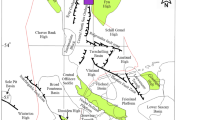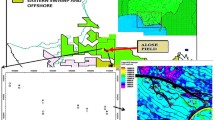Abstract
The low-frequency component of seismic data is an inevitable part to obtain absolute P-impedance (\(I_{p}\)) and \(V_{p} /V_{s}\) ratio of the subsurface, especially for the reservoir sweet spot. In this work, we train the deep feedforward neural network (DFNN) with band-pass seismic data and well log data to obtain favorable low-frequency components. Specifically, the Bayesian inference strategy is first applied to the pre-stack constrained sparse spike inversion process, obtaining an “initial” inverted band-pass parameters, which are subsequently used as input when applying the DFNN algorithm to predict low- and band-pass parameters. Moreover, the high linear correlation coefficient between the DFNN-based inversion results and the realistic well logging curves of the blind wells demonstrates that the DFNN-based inversion scheme exhibits strong robustness and good generalization ability. Ultimately, we apply the proposed DFNN-based inversion strategy to a tight sandstone reservoir located at the Sichuan basin field from onshore China. Both low- and band-pass \(I_{p}\) and \(V_{p} /V_{s}\) inverted for the clastic formation of the Sichuan basin show a strong correlation with the corresponding \(I_{p}\) and \(V_{p} /V_{s}\) logs.



















Similar content being viewed by others
References
Alfarraj M, AlRegib G (2019) Petrophysical property estimation from seismic data using recurrent neural networks. Available online at: arxiv:1901.08623
Araya-Polo M, Jennings J, Adle A, Dahlke T (2018) Deep-learning tomography. Lead Edge 37(1):58–66
Ball V, Blangy JP, Schiott C, Chaveste A (2014) Relative rock physics. Lead Edge 33(3):276–286
Biswas R, Sen MK, Das V, Mukerji T (2019) Prestack and post stack inversion using a physics-guided convolutional neural network. Interpretation 7(3):SE161–SE174
Buland A, Omre H (2003) Bayesian linearized AVO inversion. Geophysics 68:185–198
Caers J (2011) Modeling uncertainty in the earth sciences. Wiley, Chichester
Connolly P (1999) Elastic impedance. Lead Edge 18(4):438–438
Das V, Mukerji T (2020) Petrophysical properties prediction from prestack seismic data using convolutional neural networks. Geophysics 85(5):N41–N55
Das V, Pollack A, Wollner U, Mukerji T (2019) Convolutional neural network for seismic impedance inversion. Geophysics 84(6):R869–R880
Debeye HWJ, Vanriel P (1990) Lp-Norm deconvolution. Geophys Prosp 38(4):381–403
Deutsch CV (2002) Geostatistical reservoir modeling. Oxford University Press, New York
Di H, Chen X, Maniar H, Abubakar A (2020) Semi-supervised seismic and well log integration for reservoir property estimation. In: SEG program expanded abstracts, 2166–2170
Doyen PM, Guidish TM (1992) Seismic discrimination of lithology: a Monte Carlo approach. In R. E. Sheriff, (ed.), Reservoir geophysics: SEG, 243–250
Eidsvik J, Avseth P, Omre H, Mukerji T, Mavko G (2004) Stochastic reservoir characterization using prestack seismic data. Geophysics 69:978–993
Eidsvik J, Mukerji T, Bhattacharjya D (2015) Value of information in the earth sciences, (integrating spatial modeling and decision analysis). Cambridge University Press, London
Goodfellow I, Bengio Y, Courville A (2016) Deep learning. MIT Press, Boston
Grana D, Verma S, Pafeng J, Lang X, Sharma H, Wu W, Campbell-Stone E, Ng K, Alvarado V, Mallick S, Kaszuba J (2017) A rock physics and seismic reservoir characterization study of the rock springs uplift, a carbon dioxide sequestration site in Southwestern Wyoming. Int J Greenhouse Gas Control 63:296–309. https://doi.org/10.1016/j.ijggc.2017.06.004
Hampson DP, Russel BH (2005) Simultaneous inversion of pre-stack seismic data. In: 75th Annual international meeting, SEG, expanded abstracts 1633–1637
Kelly M (2001) AVO inversion, part 1: isolating rock property contrasts. Geophysics 20(3):320
Krizhevsky A, Sutskever I, Hinton G (2012) ImageNet classification with deep convolutional neural networks. Adv Neural Inf Process Syst 25:1097–1105
LeCun Y, Bengio Y, Hinton G (2015) Deep learning. Nature 521:436–444. https://doi.org/10.1038/nature14539
Li H, Lin J, Wu BH, Gao JH, Liu NH (2021) Elastic properties estimation from prestack seismic data using GGCNNs and application on tight sandstone reservoir characterization. IEEE Trans Geosci Remote Sens 60:1–21
Lopez-Moreno I, Gonzalez-Dominguez J, Martinez D (2016) On the use of deep feedforward neural networks for automatic language identification. Comput Speech Lang 40:46
Mesdag PR, Marquez D, de Groot L, Aubin V (2010) Updating low frequency model. In: 72nd EAGE conference and exhibition incorporating SPE EUROPEC, Barcelona
Monajemi H, Donoho DL, Stodden V (2016) Making massive computational experiments painless: big data, 2368–2373
Mukerji T, Jørstad A, Avseth P, Mavko G, Granli JR (2001) Mapping lithofacies and pore-fluid probabilities in a North Sea reservoir: seismic inversions and statistical rock physics. Geophysics 66:988–1001
Peters B, Granek J, Haber E (2019) Multi-resolution neural networks for tracking seismic horizons from few training images. Interpretation 7(3):1–54. https://doi.org/10.1190/int-2018-0225.1
Richardson A (2018) Seismic full-waveform inversion using deep learning tools and techniques. http://arxiv.org/abs/1801.07232
Russell BH, Gray D, Hampson DP (2011) Linearized AVO and poroelasticity. Geophysics 76(3):C19–C29
Yuan SY, Wang SX, Luo YE, Wei WW, Wang GC (2019) Impedance inversion by using the low-frequency full-waveform inversion result as an a priori model. Geophysics 84:R149–R164
Yuan SY, Jiao XQ, Luo YE, Sang WJ, Wang XS (2021) Double-scale supervised inversion with a data-driven forward model for low-frequency impedance recovery. Geophysics 0:1–102
Zheng Y, Zhang Q (2018) Pre-stack seismic inversion using deep learning. In: Presented at 1st EAGE/PESGB workshop on machine learning. Downloaded 07/30/19 to 180.101.128.24
Funding
None.
Author information
Authors and Affiliations
Contributions
XM contributed to the conception of the study; XH and BW performed the experiment; ZW contributed significantly to analysis and manuscript preparation; HZ performed the data analyses and wrote the manuscript; HW and XM helped perform the analysis with constructive discussions.
Corresponding author
Ethics declarations
Conflict of interest
All authors declares that they have no conflict of interest.
Ethics approval
All authors approve that this paper has not been submitted or published anywhere.
Consent to participation
All authors consent to participate in this work.
Consent for publication
All authors consent to publish this work.
Additional information
Edited by Prof. Sanyi Yuan (ASSOCIATE EDITOR) / Prof. Michał Malinowski (CO-EDITOR-IN-CHIEF).
Appendix A
Appendix A
This appendix differentiates the regularization term \(R(m)\) in Eq. 6. \(R(m)\) can be written as:
Taking the derivative of \(R(m)\) with respect to \(m_{k}\), then we can get:
If expanding the second term of Eq. (18), then we have:
By using the fact \(\frac{{\partial m_{p} }}{{\partial m_{q} }} = \delta_{pq} \left\{ {\begin{array}{*{20}l} { = 1,} \hfill & {{\text{if}}\,p = q} \hfill \\ { = 0,} \hfill & {{\text{if}}\,p \ne q} \hfill \\ \end{array} } \right.\), Eq. (19) can be written as:
After changing the order of summation of Eq. (20), then:
where \(Q_{kn} = \sum\nolimits_{i = 1}^{N} {\frac{{2{{\varvec{\Phi}}}_{kn}^{i} }}{{1 + {\mathbf{m}}^{T} {{\varvec{\Phi}}}^{i} {\mathbf{m}}}}, \, k,n = 1,2,3, \ldots ,3N}.\)
Rights and permissions
About this article
Cite this article
Mao, X., Han, X., Wu, B. et al. P-Impedance and Vp/Vs prediction based on AVO inversion scheme with deep feedforward neural network: a case study from tight sandstone reservoir. Acta Geophys. 70, 563–580 (2022). https://doi.org/10.1007/s11600-021-00720-4
Received:
Accepted:
Published:
Issue Date:
DOI: https://doi.org/10.1007/s11600-021-00720-4




